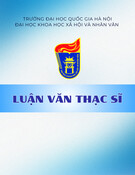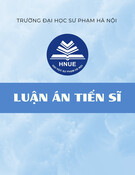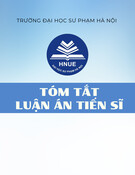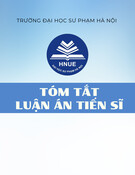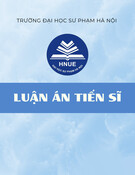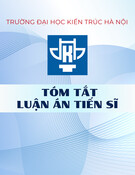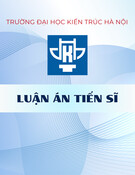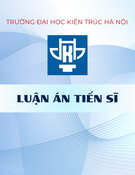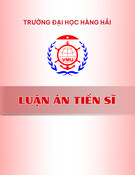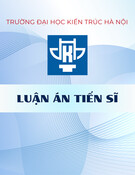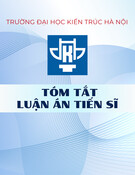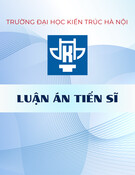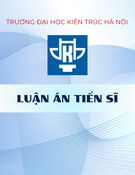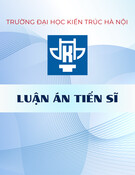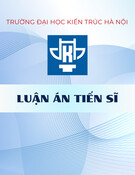
1
INTRODUCTION
1. Reasons for choosing the thesis
1. In teaching, using exercises is the important tool, contributing to good
performance of the basic content of the education principle: Theory must go hand in
hand with practice; simultaneously, improving interest, practicing study skills for the
students, enhancing teaching- training quality in the professional schools.
Therefore, it is very important to design and use a diversified and effective
system of exercises in teaching. However, there are not many concerns about how to
achieve a good and interesting system of exercises. In particular, there is not any
practical scientific research about the technique of designing exercises, the system of
exercises for a lesson; the system of exercises for a textbook and the procedure of
using the exercises in teaching by the method of credit training regime.
Currently, there are many shortcomings in using the exercises in teaching. It
can be seen that method of using the exercises system of teachers in teaching is not
good; the teachers only use the exercises to improve knowledge, they do not pay
attention to classifying the exercises to practice logic thinking, occupational skills of
the students. So that, examination results shows that the students have good
understanding about theories; but their practice skills are not good, their capacities of
orienting and solving issues are still weak.
2. Improving training quality of the teachers is an important task of many
pedagogy schools at the present. In the previous years, building and developing group
of the teachers have been well- recognized by many teachers; and have created a
movement in many places. However, there are many limitations in the training work
such as: teaching method of the teachers still put emphasis on theory, not practice;
practicing the teaching skills is not carried out regularly and adequately; entrance
mark of the pedagogy schools or the multi-faculty schools with the pedagogy faculty
in the recent years is low, of which many schools only require the average mark
regulated by Ministry of Education & Training; many students are lazy, passive, etc
without good study motive. To solve the above problems, it should renovate
comprehensively the training work of the pedagogy schools; of which innovating the
teaching method of the teachers towards developing activeness, independence,
positiveness of the students in studying, practicing their occupational skills is the
urgent requirements in the current period.
3. In the pedagogy schools, pedagogics is the professional subject which plays
a special role in practicing the occupational skills, awareness, ethics for the students.
However, practicing the teaching and training skills for the students through this
subject is not regularly; the used exercises in teaching are usually based on
experiences; lack systematic without being built and used on the basic of a clear
theoretical foundation.
Therefore, study results of the pedagogics subject are still low; there are many
limits in practicing, and solving occupational cases.
4. Currently, the universities do not apply the method of credit training regime.
This new training method can strengthen self-study capacity of the students.

2
Therefore, designing and using the system of exercises in teaching will help the
students become positive in their study, their occupational practice, not only in the
class but also outside class-
For these reasons, choosing the thesis namely “Design and use the system of
exercises in teaching the pedagogics subject in universities” is an urgent matter to
implement objectives of the graduate education in the present period.
2. Aims of the research:
Design the system of exercises and propose the utilization procedure in
teaching to stimulate the students to actively search knowledge through study
activities; contribute to improve the training quality of the teachers in the pedagogy
schools currently.
3. Object and subject of the research:
3.1. Research object: Teaching activity for the pedagogics subject in the pedagogy
schools.
3.2.Research subject: Relationship between exercises and components of the
teaching process
4. Scientific hypothesis
If it can design a system of the exercises for the pedagogics, which assures
diversity and balance between theoretical exercises- practical exercises, reappearing
exercises- creative exercises; simultaneously, can use a system of the exercises,
which uphold the activeness, positiveness, creativeness of learners in their study; it
can improve teaching and training quality in the pedagogy schools currently.
5. Research tasks
5.1. Research theoretical foundation for designing and using the system of
exercises in teaching the pedagogics in the university.
5.2. Investigate reality of designing and using the system of exercises in
teaching the pedagogics in the university.
5.3. Design the system of exercises and use the system of exercises according
to the proposed procedure.
5.4.Organize teaching experiment to check science, feasibility of the system
of pedagogics exercises and the proposed utilization procedure.
6. Scope of the research
6.1. Limit of the research contents: The thesis concentrates on studying the
system of exercises in part I: General issues of the pedagogics (Unit of study:
pedagogics) in the universities.
6.2. Limit of the research object: Sophomore of the regular graduate pedagogy
training mode, lecturer rs of Psychology- Education
6.3. Limit of field and time of the research
- Investigate, survey in schools: Hanoi University of Education, Hong Duc
University, Hue University of Education, Sai Gon University, Ho Chi Minh City
University of Education.
- Pedagogy experiment: in Hong Duc University
7. Methodology
7.1. Theoretical methodologies: Including analysis, synthesis, systematization of
data; overview and comparison method; historical method

3
7.2. Practical methodologies: Investigation method; method of researching
products, activities; method of pedagogy experiment; method of mathematical
statistics.
8. New contributions of the thesis
8.1. About theory:
The thesis will clarify the theoretical issues about the exercises, the new points
of the pedagogics program in the university currently by the method of credit training
regime.
- Finalize and develop the theory of designing and using the exercises in
teaching including the requirements, principles, procedures of designing: an
exercise, a system of exercises for a lesson, a system of exercises for a textbook;
and using the exercises suitable with features of each lesson hour.
8.2. About reality:
By investigating status of using the exercises in teaching the Pedagogics to
study awareness, attitude of the students about importance of using the exercises in
teaching, objective and subjective reasons affecting study results of the pedagogics of
the students; of which identifying the most important subjective reason.
- Use techniques of designing the exercises to design 74 exercises for the
Pedagogics in the part: General issues of Pedagogics including the theoretical
exercises, practical exercises, reappearing exercises, creative exercises; of which
chapter I: 14 exercises, chapter II: 29 exercises, chapter III: 31 exercises; and
organize experiment of the designed system of exercises.
9. Structure of the thesis: Besides the Introduction and Conclusion, the thesis
contains 04 chapters.
CHAPTER 1
THEORETICAL FOUNDATION OF DESIGNING AND USING EXERCISES
IN TEACHING PEDAGOGICS IN UNIVERSITIES
1. 1. Research history of the issue
1.1.1. In the world
The issue about designing and using the system of exercises in teaching has
been concerned by many scientists all over the world. From the 18th century, Swiss
Educator- Pestalogi (1746 –1827) confirmed that “Capacity of implementing things
required by heart and brain is mostly based on action skills of human. Such skills are
formed thanks to a system of special practice exercises with system and increasingly
level of difficulties and complexities from simple skills to complex skills”. [61, p.120].
In the beginning of XX century, L.X Vugotxki (1896 –1934)- Soviet
psychologist built the theory of “Sub-development zone”. He believed that at each
development period of children, there were 2 levels: current development level and
nearest development zone. It could realize these two levels by the way which the
students solved their study tasks with the two different levels. The first level was the
exercises which the children could do by themselves; and the second level was the
difficult exercises with assistance of adults.
At the end of 80’s of the XX century, some Soviet Union authors such as G.C.
Koschuc [103]; G.A. Ball [100], V. C. Avanhexop [96, 97, 98, 99], etc considered the

4
teaching process as a process of organizing the students to do the exercises. Besides,
the authors such as Socolovskaia 1971, Abramova,P.B. Gophman, Kadoshicov, etc
[54], [58] have got many writings/ works mentioning natures, meanings, contents and
methods of designing, using questions, exercises in teaching.
Discussing about types of exercises, many authors such as I. Lecner, N. A
Rubakin, Rretke, Robert J. Marzano , Debra J. Pickering, Jane E. Pollock, I.F
Kharlamov, N. V. Borđôpxkaia and A.A. Rean [76], [77], [57], [33], [101], etc have
mentioned types of exercises as follows: cognitive exercises, exercises of practicing
skills, case exercises, creative exercises, etc; of which the case exercises have been
mentioned by many authors mostly.
Therefore: researching and using the exercises in teaching is not a new issue in
reality, but it were mentioned by the scientists very early. The similar point among
the authors is that: Doing exercises is the process of strengthening knowledge,
upholding inner force, intelligence of learners; improving interest, creativeness in
science; contributing to renovation of teaching method in schools. However, the
theory about techniques of designing and using the exercises does not achieve much
concern; method of evaluating results of each exercise has not been researched. This
limits effects and values of using the exercises in teaching.
1.1.2. In Vietnam
Many scientists have concerned and have got many writings about the issue of
designing and using the exercises in teaching, such as Vu Van Tao, Tran Van Ha,
Nguyen Ngoc Quang, Nguyen Canh Toan, Thai Duy Tuyen, etc. Using the system of
exercises in teaching plays an important role in creating the study cases to stimulate
the students to develop their thinking, improve self-study capacity. The exercises
include two basic types which are the theoretical exercises and the practical exercises.
In each type of exercises, there are both the reappearing exercises and the creative
exercises.
With this direct of research, there are some scientific research works of some
authors such as Bui Thi Mui, Phan Thi Lan Phuong, Tran Thi Huong, Vu Thi Nguyet,
Le Thanh Oai, Tran Dinh Chau, etc.
General comments:
Firstly, most of the authors have clarified importance of using the exercises in
teaching; of which the case exercises achieved the most concerns of the scientists.
Secondly, research results of some recent scientific works about the pedagogics
shows that the research works do not deeply clarify requirements, principles,
procedures of designing and using an exercises, a system of exercises for a lesson/
program, a system of exercises for a textbook in teaching by the method of credit
training regime. The research results only give the requirements, principles and
procedures of designing a specific type of exercises; classifying the theoretical
exercises- the practical exercises, the reappearing exercises- the creative exercises in
each type of exercises is mostly not mentioned.
Thirdly, the Pedagogics is the subject including the general issues about theory
of teaching and training; and the students do not learn this subject in the primary
schools. Therefore, if teaching is not hand in hand with reality, study with practice, it

5
will make the subject become uninteresting, the students are not interested in study,
leading to limitation of the students’ creativeness.
1.2. Some basic concepts
1.2.1. Design
Design is the process of setting up project, plan for a specific activity, of which
creativeness of researchers will be presented, aiming at achieving their purposes.
The design must include enough basic factors and establish necessary and
reasonable relation among these factors. All the factors and relations create the clear
procedure about logic and contents.
1.2.2. Exercise
Exercise is one type of study task made by teacher to students; on the basic
of known information, the students have to think, find out solutions to comprehend
study contents; practice skills; achieve objectives of the lesson, the subject.
1.2.3. System of exercises
“System of exercises is a set of exercises in a certain order, of which there is mutual relation
among the exercises to implement objectives of the lesson hour, lesson and subject”.
A lesson can be carried out in a lesson hour or many lesson hours. Each lesson hour
includes many stages such as: introducing, lecturing new lesson, strengthening, giving
homework, etc; among the stages, there is mutual relation towards implementing objectives
of the lesson. In teaching, the teachers can use the exercises in all the stages of one lesson
hour.
1.2.4. Design the system of exercises
“Designing the system of exercises is the process of researching, collecting
information, editing and designing the exercises in a close process, matching with logic of
contents of the lesson, the subject to implement the teaching tasks”.
According to the above concept, it can be seen that designing the system of exercises has the
following features:
- Designing the system of exercises is the intelligent activity, creative thinking of
researchers; of which the intelligent operations such as analysis, synthesis, generalization,
etc are regularly used to analyze the collected information, editing or designing the exercises
by an identified objective.
- Designing the system of exercises must comply with the certain principles, assure
the requirements and implement under a strict procedure.
- Design the system of exercises has to reflect features of the subject and must be
diversified to form the occupational skills for the students on the basic of making use of the
theoretical knowledge into different cases of the reality.
1.2.5. Pedagogics exercise
“Pedagogics exercise is one type of the study task, of which including the theoretical
and practical exercises to help the students comprehend knowledge; improve attitude,
occupational ethics; and practice teaching and training skills; contribute to implementing
graduate objectives”.
Characteristics of the pedagogics exercises
- The pedagogics exercises help the students have a thorough grasp of theory about
teaching and training in the primary schools; practice their occupational skills.

